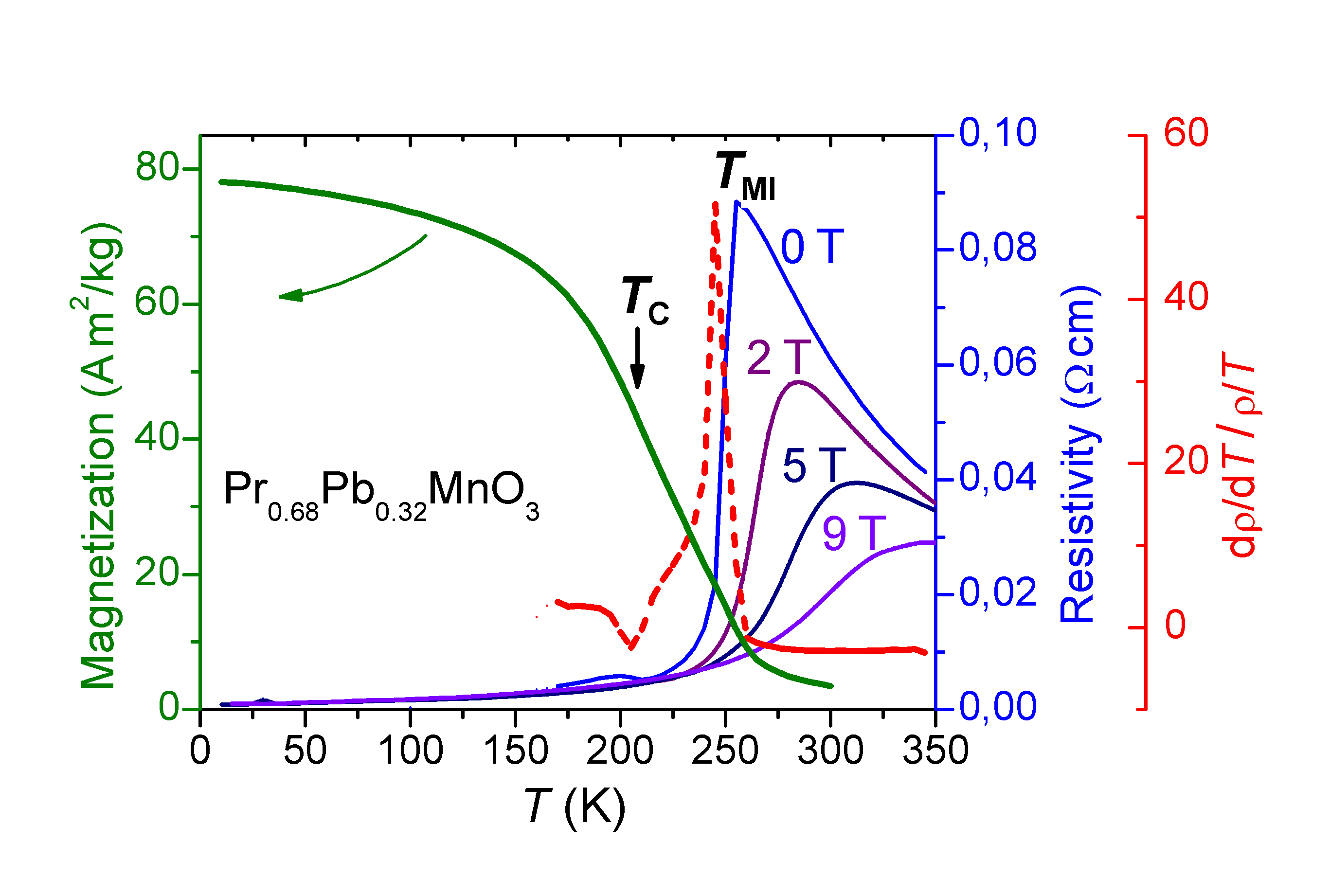
| The preparation and properties of PPMO single crystals were reported elsewhere [B. Padmanabhan et al., J. Magn. Magn. Mater. 307 (2006) 288; Phys. Rev. B 75 (2007) 024419. In Pr1-xPbxMnO3, the Curie temperature Tc and the temperature of the metal-insulator transition, TMI do not coincide, and metallic conductivity occurs in the paramagnetic state in parts of the phase diagram, a phenomenon uncommon to mixed valence manganites. The figure shows the temperature dependence of magnetization (M) and resistivity (ρ) at selected magnetic fields of a PPMO sample. The magnetoresistance, [ρ(H)–ρ(0)]/ρ(0), is found to be ~90% close to TMI and at a field of 9 T. From the maximum change in slope of the M vs. T curve, Tc ~ 210 K was estimated which is distinctly lower than the corresponding TMI ≈ 255 K [47]. The scaling analysis near the critical temperature indicated in addition that the underlying magnetic transition is a conventional one, with short-range Heisenberg-like critical exponents. This study emphasizes the presence of additional frustrated couplings which intercepts the formation of long-range order. Deviation of the susceptibility from the Curie-Weiss law above Tc and history-dependent transport properties [R.-W. Li et al., Phys. Rev. B 71 (2005) 092407] suggest the presence of small magnetic metallic clusters above Tc that form percolating metallic paths in the paramagnetic metallic state upon reducing T. Note that evidence for the formation of localized ~1.2 nm magnetic clusters above Tc in another mixed valent manganite has earlier been found by small-angle neutron scattering measurements [J. M. DeTeresa et al., Nature 386 (1997) 256]. We also note the sharpness of the resistive transition which can be inferred from the logarithmic derivative of the resistivity, (dρ/dT)/(ρ/T), cf. figure above. Such a sharp metal-insulator transition is indicative of a largely strain-free sample. |  |
However, the distributions near TMI [cf. above figure 2(h),
(i)] are significantly broadened compared to both, low T (30 K) and high T = 300 K >
TMI. The sharp distribution at T = 300 K clearly indicates
that these broad distributions of G0 at intermediate T reflect a sample property rather
than an instrumental influence. The T dependences observed in STS arise mainly from a
strongly changing DOS of PPMO at these temperatures. This change of electronic properties can be
explained by the release of lattice distortions around TMI,
when immobilized polaronic carriers become successively mobile producing spatially inhomogeneous
conductance distributions. The positive temperature coefficient of resistance observed above
Tc can be explained by electronic transport through
percolating metallic regions. Moreover, the inhomogeneities due to phase separation may directly
influence the DOS on a local scale: nanometer-size particles are known for a modified DOS with
respect to the bulk.
By comparing topography and conductance maps taken over identical areas we could exclude that the
phase separation is directly correlated with topography. Moreover, scans over areas of 20×20
nm2 with a lateral resolution of 0.4 nm exhibit similar sizes
of the individual phases as in case of 50×50 nm2 scans.
Non-identical trace and retrace maps reveal a slow glassy dynamics of the electronic states and
confirm that the phase separation observed here is not due to static chemical disorder.
Our findings are distinct from previous experimental results where PS was seen on a
(sub-)micrometer scale and persisted deep into metallic regime. It remains an open question,
whether the particular properties of PPMO with a metallic paramagnetic state for
Tc< T < TMI
are responsible for the clear observation of nanometer-scale phase separation and its confinement
to this temperature range, and whether the result can be generalized to other mixed valence
manganites. Further, the specific pattern of electronic inhomogeneity in the local surface
DOS is certainly affected by unavoidable intrinsic disorder, induced by random chemical
substitutions and/or surface effects. In addition, disorder effects due to size differences
between A-site Pr3+ and Pb2+
ions may play a role. However, the observed nanometer-scale phase separation is not a simple
and fixed result of static chemical disorder, as can be inferred from the homogeneity of the
electronic properties deep in the metallic state (low T) as well as in the insulating
one (300 K). Hence, in order to resolve the relevance of disorder effects on PS and the associated
length scale, similar spatially resolved STS studies on different manganites are called for.